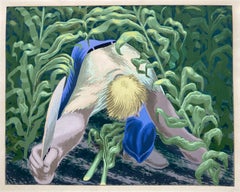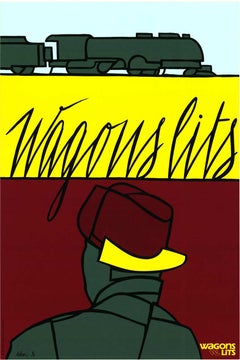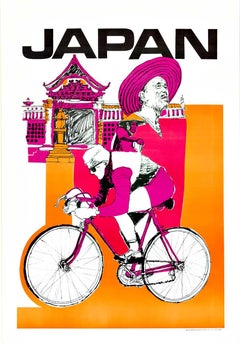Steffen, Bernard Joseph Art
to
1
1
1
1
PULLING CORN (FODDER HOPPER) - Scarce Print!
By Bernard Joseph Steffen
Located in Santa Monica, CA
BERNARD (JOSEPH) STEFFEN (1907 – 1980)
PULLING CORN (FODDER HOPPER) c. 1935-45
Color serigraph signed with a full signature below the image at the lower right sheet edge . Unknown e...
Category
1930s Modern Steffen, Bernard Joseph Art
Materials
Screen
Related Items
Original "Wagon Lits" pop art style serigraph travel by train poster
By Valerio Adami
Located in Spokane, WA
Original “Wagon Lits” serigraph poster by the artist Valerio Adami.
It was printed in France by GrafiCaza (Michel Caza), one of the finest serigraph companies on woven paper—in exce...
Category
1990s American Modern Steffen, Bernard Joseph Art
Materials
Screen
H 36 in W 24 in D 0.05 in
Original "Japan" vintage travel poster serigraph bicycle
Located in Spokane, WA
Original Japan serigraph travel poster. Linen backed in very find condition, ready to frame.
Japanese travel posters have a rich history and are renowned for their captivating ...
Category
1970s Modern Steffen, Bernard Joseph Art
Materials
Screen
BRUSHWOOD - Modern Plants Unique Screen Printing 1/1 , Joyful, Colorful
By Anna Ładecka
Located in Salzburg, AT
Unique Screen Printing 1/1, signed by artist.
Anna Ładecka is a Paris-based polish illustrator and painter.
Graduated from Warsaw Academy of Fine Arts, Master of Art - Diploma in p...
Category
2010s Contemporary Steffen, Bernard Joseph Art
Materials
Screen, Archival Paper
Harry Shokler, Island Harbor
By Harry Shokler
Located in New York, NY
Harry Shokler used serigraphy to great advantage in this landscape. It's colorful and detailed.
It is signed in the image at the lower left. When printmakers began making serigraphs...
Category
1940s American Modern Steffen, Bernard Joseph Art
Materials
Screen
Eyvind Earle Contemporary Serigraph "Eucalyptus Forest"
By Eyvind Earle
Located in Alamo, CA
This striking contemporary abstract serigraph by Eyvind Earle (1916-2000) is entitled "Eucalyptus Forest". It depicts a stylized scene of cloud like trees with a radiating pattern in the foreground, possibly tilled fields. It is signed in pencil in the lower right and numbered in pencil 119/267 in the lower left.
This colorful print is presented in a glossy black wood frame with a French mat...
Category
Late 20th Century Contemporary Steffen, Bernard Joseph Art
Materials
Screen
H 24.25 in W 26 in D 1.25 in
Blimpie, America's Best Dressed Sandwich Pop Art Photo Realist Silkscreen Litho
By Charles Ford
Located in Surfside, FL
Charles Ford, American Photo Realist Pop Artist Texas Artist
Photorealism is a movement which began in the late 1960's, in which scenes are painted in a style closely resembling phot...
Category
20th Century Photorealist Steffen, Bernard Joseph Art
Materials
Screen
Modernist Silkscreen Screenprint 'El Station, Interior' NYC Subway, WPA Artist
By Anthony Velonis
Located in Surfside, FL
screenprint printed in color ink on wove paper. New York City subway station interior.
Anthony Velonis (1911 – 1997) was an American painter and designer born in New York City who helped introduce the public to silkscreen printing in the early 20th century.
While employed under the federal Works Progress Administration, WPA during the Great Depression, Velonis brought the use of silkscreen printing as a fine art form, referred to as the "serigraph," into the mainstream. By his own request, he was not publicly credited for coining the term.
He experimented and mastered techniques to print on a wide variety of materials, such as glass, plastics, and metal, thereby expanding the field. In the mid to late 20th century, the silkscreen technique became popular among other artists such as Robert Rauschenberg and Andy Warhol.
Velonis was born into a relatively poor background of a Greek immigrant family and grew up in the tenements of New York City. Early on, he took creative inspiration from figures in his life such as his grandfather, an immigrant from the mountains in Greece, who was "an ecclesiastical painter, on Byzantine style." Velonis attended James Monroe High School in The Bronx, where he took on minor artistic roles such as the illustration of his high school yearbook. He eventually received a scholarship to the NYU College of Fine Arts, into which he was both surprised and ecstatic to have been admitted. Around this time he took to painting, watercolor, and sculpture, as well as various other art forms, hoping to find a niche that fit. He attended NYU until 1929, when the Great Depression started in the United States after the stock market crash.
Around the year 1932, Velonis became interested in silk screen, together with fellow artist Fritz Brosius, and decided to investigate the practice. Working in his brother's sign shop, Velonis was able to master the silkscreen process. He reminisced in an interview three decades later that doing so was "plenty of fun," and that a lot of technology can be discovered through hard work, more so if it is worked on "little by little."
Velonis was hired by Mayor LaGuardia in 1934 to promote the work of New York's city government via posters publicizing city projects. One such project required him to go on a commercial fishing trip to locations including New Bedford and Nantucket for a fortnight, where he primarily took photographs and notes, and made sketches. Afterward, for a period of roughly six months, he was occupied with creating paintings from these records. During this trip, Velonis developed true respect and affinity for the fishermen with whom he traveled, "the relatively uneducated person," in his words.
Following this, Velonis began work with the Public Works of Art Project (PWAP), an offshoot of the Civil Works Administration (CWA), where he was assigned to serve the different city departments of New York. After the formation of the federal Works Progress Administration, which hired artists and sponsored projects in the arts, he also worked in theater.
Velonis began working for the federal WPA in 1935. He kept this position until 1936 or 1938, at which point he began working in the graphic art division of the Federal Art Project, which he ultimately led. Under various elements of the WPA program, many young artists, writers and actors gained employment that helped them survive during the Depression, as well as contributing works that created an artistic legacy for the country.
When interviewed in December 1994 by the Library of Congress about his time in the WPA, Velonis reflected that he had greatly enjoyed that period, saying that he liked the "excitement" and "meeting all the other artists with different points of view." He also said in a later interview that "the contact and the dialogue with all those artists and the work that took place was just invaluable." Among the young artists he hired was Edmond Casarella, who later developed an innovative technique using layered cardboard for woodcuts.
Velonis introduced silkscreen printing to the Poster Division of the WPA. As he recalled in a 1965 interview: "I suggested that the Poster division would be a lot more productive and useful if they had an auxiliary screen printing project that worked along with them. And apparently this was very favorably received..."
As a member of the Federal Art Project, a subdivision of the WPA, Velonis later approached the Public Use of Arts Committee (PUAC) for help in "propagandizing for art in the parks, in the subways, et cetera." Since the Federal Art Project could not be "self-promoting," an outside organization was required to advertise their art more extensively. During his employment with the Federal Art Project, Velonis created nine silkscreen posters for the federal government.
Around 1937-1939 Velonis wrote a pamphlet titled "Technical Problems of the Artist: Technique of the Silkscreen Process," which was distributed to art centers run by the WPA around the country. It was considered very influential in encouraging artists to try this relatively inexpensive technique and stimulated printmaking across the country.
In 1939, Velonis founded the Creative Printmakers Group, along with three others, including Hyman Warsager. They printed both their own works and those of other artists in their facility. This was considered the most important silkscreen shop of the period.
The next year, Velonis founded the National Serigraph Society. It started out with relatively small commercial projects, such as "rather fancy" Christmas cards that were sold to many of the upscale Fifth Avenue shops...
Category
1980s American Modern Steffen, Bernard Joseph Art
Materials
Screen
Landscape - Screen Print by Luca Dall'Olio - 2000s
Located in Roma, IT
Landscape is an artwork realized by Luca Dall'Olio.
Materic screen printing on canvas, cm 65x50, ex. IV/XXX.
Signature and edition
On the back: Stamperia d'Arte Artevalori stamp
...
Category
Early 2000s Modern Steffen, Bernard Joseph Art
Materials
Paper, Screen
H 25.6 in W 19.69 in D 0.04 in
Stewart Wheeler, Atlantic City (New Jersey)
Located in New York, NY
The little that is know about the painter and printmaker Stewart Wheeler indicates that most of his career was spent in Philadelphia, Pennsylvania. And...
Category
Mid-20th Century American Modern Steffen, Bernard Joseph Art
Materials
Screen
Calle De La Ermita, Valencia Spain
By Guido Lopez
Located in Soquel, CA
Bright and bold screen print by Spanish artist Guido Lopez (Spain, 20th century). Signed and titled, "Guido Lopez", 12/150. Unframed. Image 22.5"H x 25"L, Mat 31"H x 34.25"L.
Category
Early 2000s Modern Steffen, Bernard Joseph Art
Materials
Screen
Nocturnal Village - Original Screen Print by Lucie Navier
By Lucie Navier
Located in Roma, IT
Nocturnal Village is an original artwork realized by the French artist Lucie Navier (1910-1996) in the 1930s.
Original black and white serigraph...
Category
1930s Modern Steffen, Bernard Joseph Art
Materials
Screen
H 9.26 in W 8.27 in D 0.04 in
La Fete a Honfleur
By Fanch (Francois Ledan)
Located in San Francisco, CA
This artwork, "La Fete a Honfleur" c.1980 is a original colors serigraph on Wove paper by French artist (Fanch) Francois Ledan, born 1949. it is hand signed an...
Category
Late 20th Century Modern Steffen, Bernard Joseph Art
Materials
Screen
Previously Available Items
Abstract Composition, Silkscreen by Bernard Joseph Steffen
By Bernard Joseph Steffen
Located in Long Island City, NY
Bernard Steffen was an American Modern artist whose oeuvre included landscape, figurative and abstract works. This 1960's silkscreen is hand-signed and...
Category
1960s Abstract Geometric Steffen, Bernard Joseph Art
Materials
Screen
Untitled (Baling Hay)
By Bernard Joseph Steffen
Located in Denver, CO
Lithograph on paper. Pencil signed and dated lower left margin. Framed dimensions are 23.5 x 27.5 x 2 inches. Image measures 11 x 14 inches.
About the Artist:
Born in Nebraska, S...
Category
1930s Steffen, Bernard Joseph Art
Materials
Lithograph
Steffen, Bernard Joseph art for sale on 1stDibs.
Find a wide variety of authentic Steffen, Bernard Joseph art available for sale on 1stDibs. You can also browse by medium to find art by Steffen, Bernard Joseph in screen print and more. Much of the original work by this artist or collective was created during the 20th century and is mostly associated with the modern style. Not every interior allows for large Steffen, Bernard Joseph art, so small editions measuring 14 inches across are available. Customers who are interested in this artist might also find the work of Alexander Archipenko, Georg Karl Pfahler, and Peter Halley. Steffen, Bernard Joseph art prices can differ depending upon medium, time period and other attributes. On 1stDibs, the price for these items starts at $2,250 and tops out at $2,400, while the average work can sell for $2,325.



